The uterus plays an important role in menstruation, pregnancy, and fertility. So yeah, it’s kind of a big deal. But chances are you never really thought about keeping your uterus healthy. Most of us don’t, until there’s a problem. Then we realize how important our uterine health is.
For example, if you develop uterine fibroids, you may suffer from heavy bleeding, painful periods, frequent urination, pain during sex, lower back pain, and complications during pregnancy and labor.1
Uterine cancer is of course another concern, as it’s the most common gynecologic cancer in the United States.2 There are two types of uterine cancer: endometrial cancer (which is most common) and uterine sarcoma (which is rare).3 Women who develop uterine cancer most often experience abnormal vaginal bleeding.4
Although we don’t yet know if there are ways to prevent these conditions, there are things we can do to help lower our risk of developing them. Let’s show the uterus some love with these 5 tips for keeping it healthy.
1. Maintain a healthy weight
2. Boost your vitamin D
3. Get moving
4. Watch your diet
Women who have a diet higher in red meat and lower in green vegetables, fruit, and dairy appear to have a higher risk of developing fibroids.6 Drinking alcohol also seems to increase the risk.6 As with most things in life, moderation is key. Yes, you can still have a burger and fries once in a while, but other times opt for the grilled chicken and side salad. Remember that healthy eating isn’t only about the number on the scale; it’s also about your body functioning at its best.
So, before we get to tip #5, it’s pretty clear that there’s a lot of overlap with tips #1 through #4. In a nutshell, a lifestyle that incorporates exercise, a balanced diet, and getting outdoors can benefit you in so many ways. And now you can add a healthier uterus to that list. However, while these tips can help lower your risk of uterine conditions, they don’t take the place of regular visits with your doctor. Which brings us to #5…
5. Seek treatment
Abnormal uterine bleeding is a common symptom of fibroids and endometrial cancer. If fibroids are the cause, there are minimally invasive ways to treat the fibroids and help relieve the symptoms. There’s no reason to put up with the pain and the negative impact on your life. If endometrial cancer is the cause, the abnormal bleeding could be an early warning sign. Most endometrial cancers develop over a period of years and getting proper treatment of pre-cancer disorders of the endometrium can lower the risk of endometrial cancer.5
A healthy uterus is a happy uterus. Following these tips can help give it the attention it deserves and will likely help the rest of you feel healthier and happier too!

If you have heavy uterine bleeding, don’t put off getting it checked out. Find a doctor who can help.
REFERENCES: 1. U.S. Department of Health & Human Services Office on Women’s Health. Uterine fibroids. https://www.womenshealth.gov/a-z-topics/uterine-fibroids. Accessed January 5, 2023. 2. Centers for Disease Control and Prevention. Uterine cancer statistics. https://www.cdc.gov/cancer/uterine/statistics/index.htm. Accessed January 5, 2023. 3. National Cancer Institute. Uterine cancer—patient version. https://www.cancer.gov/types/uterine. Accessed January 5, 2023. 4. U.S. Department of Health & Human Services Office on Women’s Health. Uterine cancer. https://www.womenshealth.gov/cancer/uterine-cancer. Accessed January 5, 2023. 5. American Cancer Society. Can endometrial cancer be prevented? https://www.cancer.org/cancer/endometrial-cancer/causes-risks-prevention/prevention.html. Accessed January 5, 2023. 6. Mayo Clinic. Uterine fibroids. https://www.mayoclinic.org/diseases-conditions/uterine-fibroids/symptoms-causes/syc-20354288. Accessed January 5, 2023. 7. National Institutes of Health. News Releases. April 15, 2013. Vitamin D may reduce risk of uterine fibroids, according to NIH study. https://www.nih.gov/news-events/news-releases/vitamin-d-may-reduce-risk-uterine-fibroids-according-nih-study. Accessed January 5, 2023.

